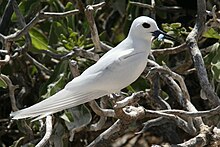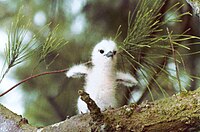White tern
| White tern | |
|---|---|

| |
| A white tern on the French Frigate Shoals | |
| Scientific classification | |
| Domain: | Eukaryota |
| Kingdom: | Animalia |
| Phylum: | Chordata |
| Class: | Aves |
| Order: | Charadriiformes |
| Family: | Laridae |
| Genus: | Gygis Wagler, 1832 |
| Species: | G. alba
|
| Binomial name | |
| Gygis alba (Sparrman, 1786)
| |
The white tern (Gygis alba) is a small seabird found across the tropical oceans of the world. It is sometimes known as the fairy tern although this name is potentially confusing as it is also the common name of Sternula nereis. Other names for the species include angel tern and white noddy in English, and manu-o-Kū in Hawaiian.
Taxonomy
The white tern was first formally described by the Swedish naturalist Anders Sparrman in 1786 under the binomial name Sterna alba.[2] The genus Gygis was introduced by the German zoologist Johann Georg Wagler in 1832.[3] The name Gygis is from the Ancient Greek guges for a mythical bird and the specific alba is Latin for "white".[4]
Molecular phylogenetic studies have shown that the white tern is more closely related to the noddies than it is to the other terns.[5] This implies that "white noddy" would be a more appropriate English name.[6]
The white tern has the following subspecies:[6]
- G. a. alba, (Sparrman, 1786): tropical islands of the south Atlantic
- G. a. candida, (Gmelin, 1789): Seychelles & Mascarene Islands to central Pacific including southern Maldives excluding ranges of next two subspecies
- G. a. microrhyncha, Saunders, 1876: Phoenix, Line and Marquesas Islands
- G. a. leucopes, Holyoak & Thibault, 1976: Pitcairn Islands
The subspecies G. a. microrhyncha, the little white tern, is sometimes considered as a separate species, Gygis microrhyncha.[7]
Description
The white tern has a wingspan of 76–87 cm (30–34 in).[8] It has white plumage and a long black bill.[9] Nesting on coral islands, usually on trees with small branches but also on rocky ledges and on man-made structures, the white tern feeds on small fish which it catches by plunge diving.
Distribution and habitat
The white tern ranges widely across the Pacific Ocean from the coasts of Chile and Colombia to New Zealand and along the eastern and southern coasts of Asia from China to India, South Maldives, the islands of the Indian Ocean, and the coast of South Africa.[10] Rarely it is also found in Japan, Madagascar, Mexico, and on some islands in the Atlantic Ocean. It is a pelagic and epipelagic bird, living along the coast and moving into wooded areas during the breeding season.
-
Fairy or white tern baby, Midway Island
-
White tern parents near their chick, in Cousin Island, Seychelles.
Behavior
This species is notable for laying its egg on bare thin branches in a small fork or depression without a nest. This behaviour is unusual for terns, which generally nest on the ground, and even the related tree-nesting black noddy constructs a nest. It is thought that the reason for the absence of nests is the reduction in nest parasites, which in some colonial seabirds can cause the abandonment of an entire colony.[11] In spite of these benefits there are costs associated with tree nesting, as the eggs and chicks are vulnerable to becoming dislodged by heavy winds. For this reason the white tern is also quick to relay should it lose the egg. The newly hatched chicks have well developed feet with which to hang on to their precarious nesting site. It is a long-lived bird, having been recorded living for 42[12] years.
Relationship with humans
This is one of the most useful of all the landfinding birds used by Pacific navigators. They generally roam no more than 45 km from their home island, to which they usually return at nightfall. Polynesians also caught these birds for food or to keep as pets.[13]
The white tern, manu-o-Kū, was named Honolulu, Hawaiʻi's official bird on April 2, 2007.[14]
The white tern is not considered threatened as it is a widespread species with several large colonies around the world.
References
- ^ BirdLife International (2012). "Gygis alba". IUCN Red List of Threatened Species. 2012. Retrieved 26 November 2013.
{{cite journal}}: Invalid|ref=harv(help) - ^ Sparrman, Anders (1786–1789). Museum Carlsonianum, in quo novas et selectas aves, coloribus ad vivum brevique descriptiones illustratas (in Latin). Vol. fasc. 1. Holmiae: Ex Typographia Regia. Plate 11.
- ^ Wagler, Johann Georg (1832). "Neue Cippen und Gattugen der Caugthiere und Vögel". Isis von Oken (in German and Latin). Column 1223.
- ^ Jobling, James A. (2010). The Helm Dictionary of Scientific Bird Names. London: Christopher Helm. pp. 37, 182. ISBN 978-1-4081-2501-4.
- ^ Baker, A.J.; Pereira, S.L.; Paton, T.A. (2007). "Phylogenetic relationships and divergence times of Charadriiformes genera: multigene evidence for the Cretaceous origin of at least 14 clades of shorebirds". Biology Letters. 3: 205–209. doi:10.1098/rsbl.2006.0606. PMC 2375939. PMID 17284401. Baker, Allan J; Pereira, Sérgio L; Paton, Tara A (2008). "Erratum: Phylogenetic relationships and divergence times of Charadriiformes genera: multigene evidence for the Cretaceous origin of at least 14 clades of shorebirds". Biology Letters. 4: 762–763. doi:10.1098/rsbl.2006.0606erratum.
- ^ a b Gill, Frank; Donsker, David, eds. (2019). "Noddies, gulls, terns, auks". World Bird List Version 9.2. International Ornithologists' Union. Retrieved 24 June 2019.
- ^ del Hoyo, J.; Collar, N.; Kirwan, G.M. "Little White Tern (Gygis microrhyncha)". In del Hoyo, J.; Elliott, A.; Sargatal, J.; Christie, D.A.; de Juana, E. (eds.). Handbook of the Birds of the World Alive. Lynx Edicions.
{{cite book}}:|access-date=requires|url=(help); External link in|chapterurl=|chapterurl=ignored (|chapter-url=suggested) (help) - ^ Gochfeld, M.; Burger, J.; Christie, D.A.; Kirwan, G.M. "Common White Tern (Gygis alba)". In del Hoyo, J.; Elliott, A.; Sargatal, J.; Christie, D.A.; de Juana, E. (eds.). Handbook of the Birds of the World Alive. Lynx Edicions.
{{cite book}}:|access-date=requires|url=(help); External link in|chapterurl=|chapterurl=ignored (|chapter-url=suggested) (help) - ^ Niethammer, K. R., and L. B. Patrick-Castilaw. 1998. White Tern (Gygis alba). in The Birds of North America, No. 371 (A. Poole and F. Gill, eds.). The Birds of North America, Inc., Philadelphia, PA. doi:10.2173/bna.371
- ^ "Gygis alba (Angel Tern, Common White Tern, Common White-Tern, Fairy Tern, White Tem, White Tern)". IUCN Red List of Threatened Species. Retrieved 2017-07-10.
- ^ Houston, D.C. (1978). "Why do fairy terns Gygis alba not build nests?". Ibis. 121 (1): 102–104. doi:10.1111/j.1474-919X.1979.tb05023.x.
- ^ Hawaii’s Comprehensive Wildlife Conservation Strategy October 1, 2005
- ^ Crowe, Andrew (2018). Pathway of the Birds: The Voyaging Achievements of Māori and their Polynesian Ancestors. Auckland: David Bateman Ltd. p. 93.
- ^ https://www.staradvertiser.com/2015/12/26/editorial/letters/article-about-monsanto-was-right-thing-to-do/
Further reading
- Yeung, N.W.; Carlon, D.B.; Conant, S. (2009). "Testing subspecies hypothesis with molecular markers and morphometrics in the Pacific white tern complex". Biological Journal of the Linnean Society. 98 (3): 586–595. doi:10.1111/j.1095-8312.2009.01299.x.
External links
- White tern videos, photos & sounds on the Internet Bird Collection



